The Econintersect November 2012 economic forecast outlook recovered slightly following last month’s free fall.
- The indicators Econintersect uses to forecast remain mixed, and several are at 2012 low points.
- The index is barely forecasting moderate economic expansion – but remains in the growth channel seen so far in 2012. Even last month’s terrible data only slightly penetrated the bottom of the channel.
- Regardless of Econintersect‘s forecast, there are potential markers for a 2012 recession – industrial production and Personal Income less transfer payments are currently below the peak values seen in July 2012. Recession start dates are defined by peak economic activity (see technical requirements of a recession below).
- Although Econintersect is not warning that the economy may be entering a recession, one alternate method we use to validate our forecasts is walking at the edge of the abyss.
This is a relative index modeling the Main Street portion of the economy – it still shows that tomorrow will be better than today, but any difference is marginal.
Econintersect prefers to forecast the economy using non-monetary measures which of late have been more stable than the dollar based expenditures, incomes or stock market indicators. As this index is modeling a section of the economy, the turning points can be (and usually are) different than GDP based models.
This post will summarize the:
- leading indicators,
- predictive portions of coincident indicators,
- review of the technical recession indicators, and
- interpretation of our own index – Econintersect Economic Index (EEI) – which is built of mostly non-monetary “things” that have been shown to be indicative of direction of the Main Street economy at least 30 days in the future.
Consider:
- the “New Normal” economy is pulsing or growing in unpredictable spurts. These spurts are evident in ECRI’s WLI, Econintersect Economic Index (although the big pulses have not occurred in 2012), and the Chicago Fed’s National Activity Index (CFNAI). This makes the economy seem at times like it is gaining traction, and other times about to fall off a cliff. These economic pulses cause some to believe the economy is heading towards a recession – as forecasts use growth rate-of-change to assess economic trends. Further, these cycles are out of phase with the calendar – and the commonly used seasonal adjusting methodologies seem to exaggerate the cycles;
- The consumer is still consuming – and recent months shows the consumer is spending more income. There are nuances in consumer spending and the current background is available here;
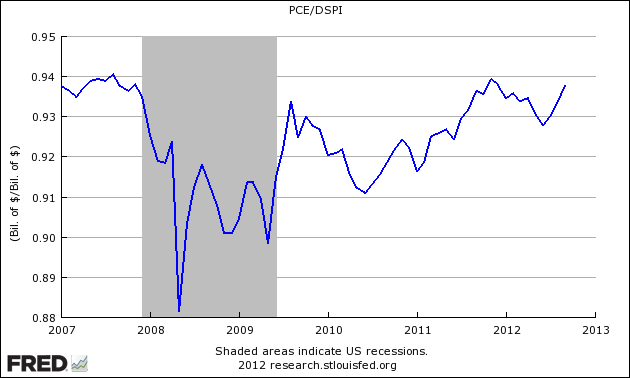
- Joe Sixpack’s economic position may be strengthening. This Econintersect index’s underlying principle is to estimate how well off Joe feels. The index was documented at the bottom of the July 2012 forecast. Joe and his richer friends are the economic drivers. Joe is the blue line in the graph below, and that is not close to the levels associated with past recessions.

- The poor jobs growth in the last few months is commensurate with the poor economic fundamentals -however the 21st century has had poor jobs growths comparatively.
- Econintersect reviews the relationship between the year-over-year growth rate of non-farm private employment and the year-over-year real growth rate of retail sales. As long as retail sales grows faster than the rate of employment gains (above zero on the below graph) – a recession is not imminent.

- Most economic releases are based on seasonally adjusted data which is revised for months after issuance so a contraction in a particular release may not be obvious for many months. The Econintersect forecast is based on non-adjusted data which, for the most part, is not subject to revision.
The leading indicators are monetary based to a large extent. (In the case of ECRI it is a knowledgeable guess as the makeup of this index is proprietary.) Econintersect‘s primary worry in using monetary based methodologies to forecast the economy is the current extraordinary monetary policy which may (or may not) be affecting historical relationships. This will only be known at some point in the future.
Econintersect does not use any portion of the leading indicators in its economic index. All leading indices in this post look ahead six months – and are all subject to backward revision.
ECRI’s Weekly Leading Index (WLI) – ECRI has been arguing strongly for almost a year that a recession is coming. In July, they stated the country was currently in a recession. ECRI’s WLI index value is now solidly above zero which according to definition means the economy six month from today will be better than today. A positive number shows an expansion of the business economy, while a negative number is contraction. This index has been on an improving trend most of 2012.
Current ECRI WLI Index
The Conference Board’s Leading Economic Indicator (LEI) – Looking at historical relationships, this index’s 3 month rate of change must be in negative territory many months (6 or more) before a recession occurred. Over the last several months, this index’s rate of change has been jumping in and out of negative territory – but is again in positive territory implying any recession is months away.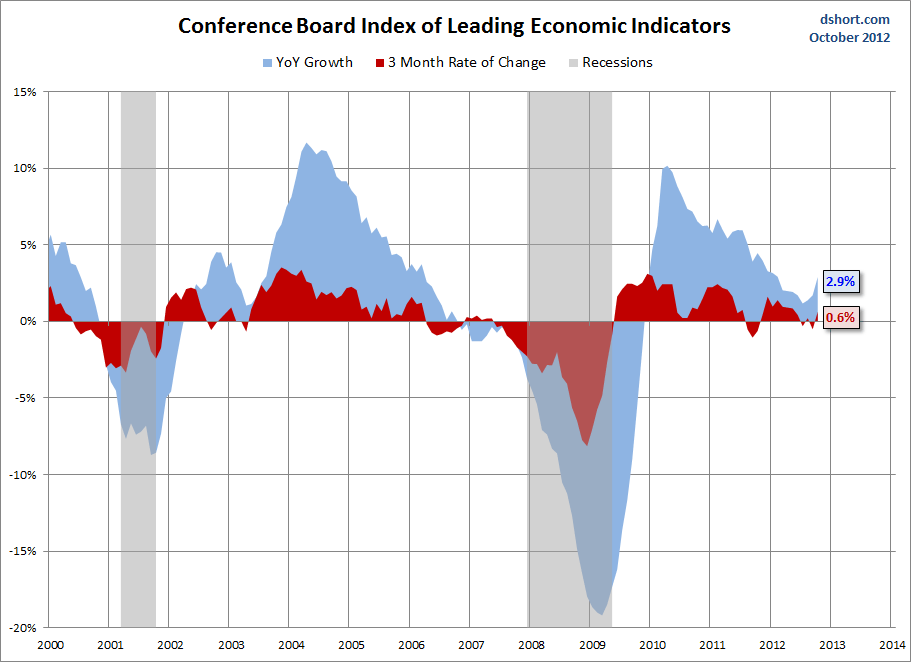
Leading Index for the United States from the Philadelphia Fed – This index is the super index for all the state indices.
The leading index for each state predicts the six-month growth rate of the state’s coincident index. In addition to the coincident index, the models include other variables that lead the economy: state-level housing permits (1 to 4 units), state initial unemployment insurance claims, delivery times from the Institute for Supply Management (ISM) manufacturing survey, and the interest rate spread between the 10-year Treasury bond and the 3-month Treasury bill.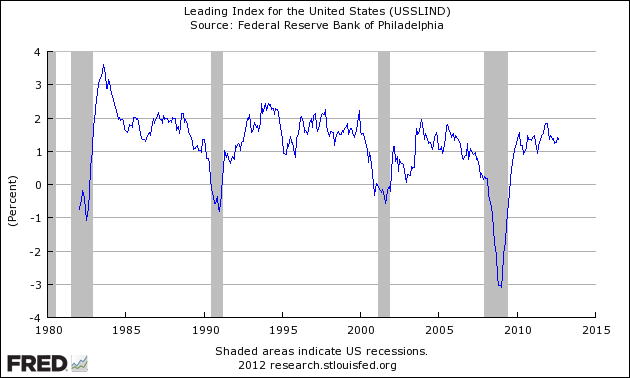
Leading Indicators Bottom Line:
- In the case of ECRI, they have several indices only available to clients. ECRI is saying the preponderance of their data (even though the WLI is clearly positive and improving) is indicating a recession is here.
- The Conference Board (LEI) is now improving and positive. No recession is in sight.
- The Philly Fed’s Leading Index is at a value of 1% – which is a warning that a recession could be coming. There has been several false warnings at the 1% line – but the 0% would be a 100% indication a recession was either underway or about to be underway.
Here is a run through of the most economically predictive coincident indices which Econintersect believes can give up to a six month warning of an impending recession – and do not have a history of producing false warnings.
Consider that every recession has different characteristics – and a particular index may not contract during a recession, or start contracting after the recession is already underway. In all the data Econintersect analyzes, there are recessionary warnings in the monetary and non-monetary import indices which are used (in part) to model future consumer behavior.
Truck transport portion of employment – to search for impending recessions. Look at the year-over-year zero growth line. For the last two recessions it has offered a six month warning of an impending recession with no false warnings. Transport is an economic warning indicator because it moves goods well before final retail sales occur. Until people stop eating or buying goods, transport will remain one of the primary economic pulse points. 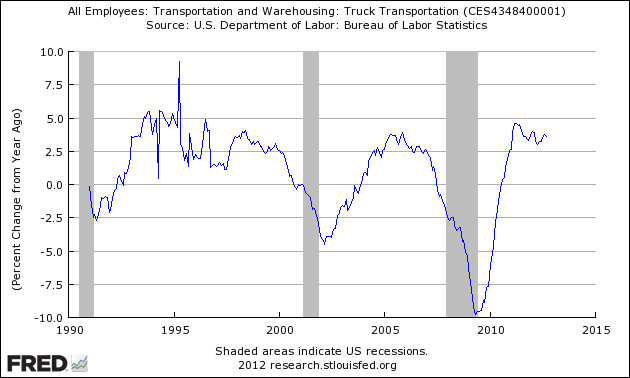
Transport employment growth is far above the zero growth line. As transport provides a six month recession warning – the implication is that any possible recession is further than six months away.
Rail – Weekly and monthly Econintersect evaluates rail movements. As stated in Truck transport employment data above, movement of goods and materials have logical and provable economic correlations. Rail particularly moves materials and finished goods months before final sales to the ultimate consumer.
Current Rail Data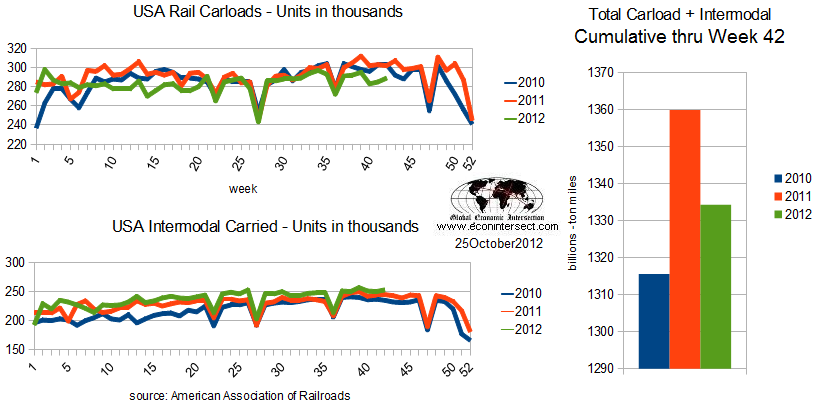
Here rail year-to-date is contracting from 2011 levels – mostly due to coal and grain. If coal and grain are removed from the equation, growth has been running between 1.5% and 4.0% per year (recent weeks have been running on the high side of this range). Coal is an alternate fuel, and the current USA government policy is to discourage coal usage. Grain movements have little correlation to the economy.
Business Activity sub-index of ISM Non-Manufacturing – this index has been jumping around most of 2012 but now seems like it is in an improving trend. The index remains above 55 (below 55 I would consider a warning that a recession might occur, whilst below 50 is almost proof a recession is underway).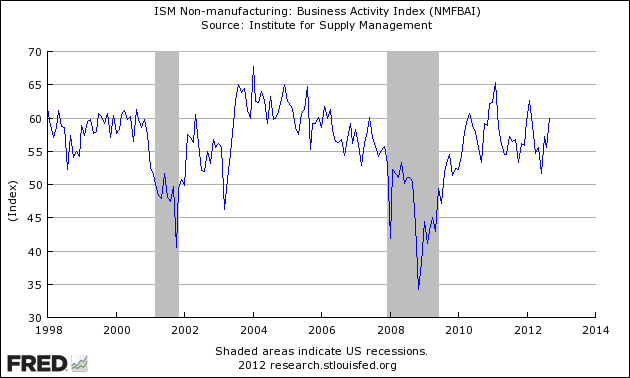
Predictive Coincident Index Bottom Line – Econintersectbelieves:
- True economic activity (not monetary based GDP) was expanding in September 2012 somewhere around 2% (plus/ minus) in many sectors of the economy using non-monetary pulse points based on these indices shown above, and other indices which Econintersect are indicative of the real economy.
- Late October’s non-monetary pulse points (based on the last few weeks of data) seem to be above 2% annual growth.
- Overall the coincident data now seems stable without large negative trends.
Sticking to the current technical recession criteria used by the NBER:
A recession is a significant decline in economic activity spread across the economy, lasting more than a few months, normally visible in real GDP, real income, employment, industrial production, and wholesale-retail sales. A recession begins just after the economy reaches a peak of activity and ends as the economy reaches its trough. Between trough and peak, the economy is in an expansion. Expansion is the normal state of the economy; most recessions are brief and they have been rare in recent decades.
….. The committee places particular emphasis on two monthly measures of activity across the entire economy: (1) personal income less transfer payments, in real terms and (2) employment. In addition, we refer to two indicators with coverage primarily of manufacturing and goods: (3) industrial production and (4) the volume of sales of the manufacturing and wholesale-retail sectors adjusted for price changes.
Below is a graph looking at the month-over-month change (note that multipliers have been used to make changes more obvious).
Month-over-Month Growth Personal Income less transfer payments (blue line), Employment (red line), Industrial Production (green line), Business Sales (orange line)
In the above graph, if a line falls below the 0 (black line) – that sector is contracting from the previous month. At this point, only personal income was negative month-over-month – and the rest improved. Again, this is a rear view mirror, is subject to revision, and is not predictive of where the economy is going. Another way to look at the same data sets is in the graph below which uses indexed real values from the trough of the Great Recession.
Indexed Growth Personal Income less transfer payments (red line), Employment (green line), Industrial Production (blue line), Business Sales (orange line)
NBER Recession Marker Bottom Line – subject to backward revision, there were recession markers put in place in July by personal income and industrial production – which are currently below their peak values. Recession start dates are defined by peak economic activity.
Econintersect believes that the New Normal economy has different dynamics than most economic models.
Economic Forecast Data
The Econintersect Economic Index (EEI) is designed to spot Main Street and business economic turning points. This forecast is based on the index’s three month moving average. The current three month rolling index value is above the lowest value seen in 2012.
The EEI is a non-monetary based economic index which counts “things” that have shown to be indicative of direction of the Main Street economy at least 30 days in the future. Note that the Econintersect Economic Index is not constructed to mimic GDP (although there are general correlations), but tries to model the economic rate of change seen by business and Main Street.
Econintersect Economic Index (EEI) with a 3 Month Moving Average (red line) 
The red line on the EEI is the 3 month moving average which is at 4.0 (up from last month’s 0.36), while the monthly index rose from 0.00 to 0.5. The economic forecast is based on the 3 month moving average as the monthly index is very noisy. Readings below 0.4 indicate a weak economy, while readings below 0.0 indicate contraction.
The upward trend of this index has been broken.
A positive value of the index represents economic expansion. If the economy was growing at the same rate, this index would return a value of 0.50. This month’s value of 0.40 shows the economy’s rate of growth is declining.
Consumer and business behavior (which is the basis of the EEI) either lead or follow old fashion industrial age measures such as GDP depending on the dynamic which is driving the economy. The main street sector of the economy lagged GDP in entering and exiting the 2007 Great Recession.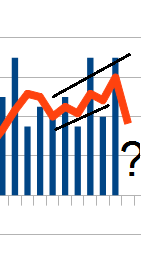
As Econintersect continues to back check its model, from time to time slight adjustments are made to the data sets and methodology to align it with the actual coincident data. To date, when any realignment was done, there have been no changes for trend lines or recession indications. Most changes to date were to remove data sets which had unacceptable backward revisions or were discontinued series. Documentation for this index was in the October 2011 forecast.
Jobs Growth Forecast Improves
The Econintersect Jobs Index is forecasting non-farm private jobs growth of 140,000 – down slightly from last month’s 145,000. There is a recentweakening of the fundamentals which historically have driven jobs growth – however there is not yet a trend established (2 months only).
Comparing BLS Non-Farm Employment YoY Improvement (blue line, left axis) with Econintersect Employment Index (red line, left axis) and The Conference Board ETI (yellow line, right axis) 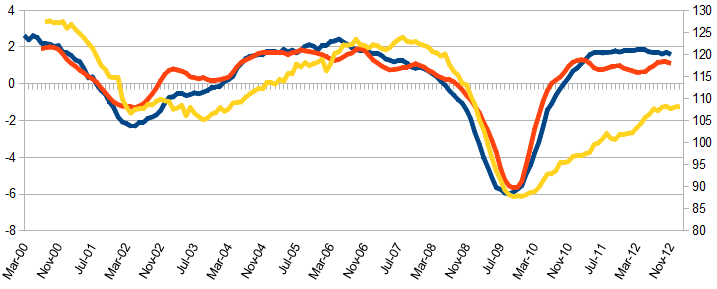
The Econintersect Jobs Index is based on economic elements which create jobs, and (explanation here) measures the historical dynamics which lead to the creation of jobs. It measures general factors, but it is not precise (quantitatively) as many specific factors influence the exact timing of hiring. This index should be thought of as a measurement of jobs creation pressures.
In addition, the BLS seasonal adjustment methodology creates wobbles in the way the data is reported.
At the present time, jobs growth year-over-year is averaging above the levels forecast by the Econintersect’s Jobs Index. The table below lists the private non-farm payroll forecasts against the current (not original headline) BLS private non-farm payrolls. Please note that the BLS data continuously is revised, and this employment forecast section of the economic forecast uses the most current BLS estimates.
Still, the Econintersect Jobs Index was predicting fewer jobs then are actually occurring. A discussion of the problem is in Ben Bernanke and the Puzzle of Employment. In the last three months, the index has been over estimating.
Econintersect Employment Forecast (blue line), Fudged Forecast* (red line), and Actual Current Estimate of BLS Non-Farm Jobs Month-over-Month Growth (green line) 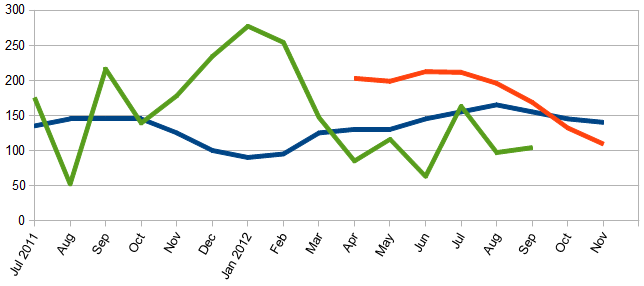
* fudged growth based on deviation between forecast & current actual using a 3 month rolling average
A fudge factor (based on deviation between the BLS actual growth and the Econintersect Employment Index over the last 3 months) is also provided. The fudge factor is fluid as the BLS has significant backward revision to their jobs numbers.
Analysis of Economic Indicators:
Econintersect analyzes all major economic indicators. The table below contains hyperlinks to posts. The right column “Predictive” means this particular indicator has a leading component (usually other then the index itself) – in other words has a good correlation to future economic conditions.
Links to Analysis Of Indicators : Predictive
Leading Indicators
ECRI economic forecasts
Leading Economic Indicator
Economic Metrics
Gross Domestic Product
Chicago Fed National Activity Index
Federal Reserve View of Economy (Beige Book)
Federal Reserve FOMC Meetings
Transport
University of Michigan Consumer Sentiment
Consumer Credit
Conference Board Consumer Confidence
Personal Consumption Expenditures (PCE)
Prices
Prices and Inflation – CPI, PPI and Export/Import
Business & Manufacturing
Wholesale Sales
Retail Sales
ISM Non-Manufacturing Survey
Manufacturing Sales
ISM Manufacturing Survey
Durable Goods
Industrial Production
Empire State Manufacturing Survey
Philly Fed Business Survey
Construction
Construction Spending
New Home Construction
Real Estate
Pending Home Sales
Case-Shiller Home Price Index
New Home Sales
Existing Home Sales
CoreLogic Home Price Index
Employment
Weekly Initial Unemployment Claims
Job Opening and Labor Turnover Survey (JOLTS)
Bureau Of Labor Statistics Jobs Report
ADP Employment Report
